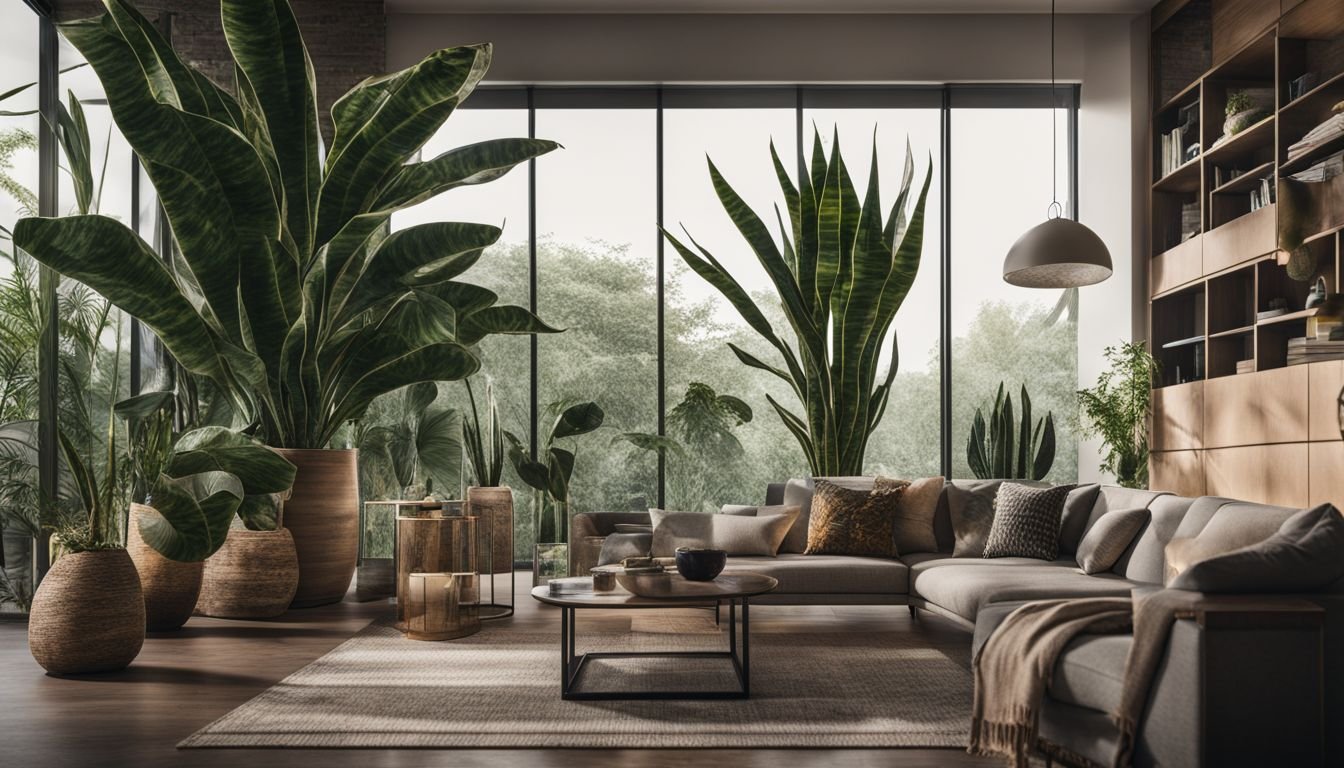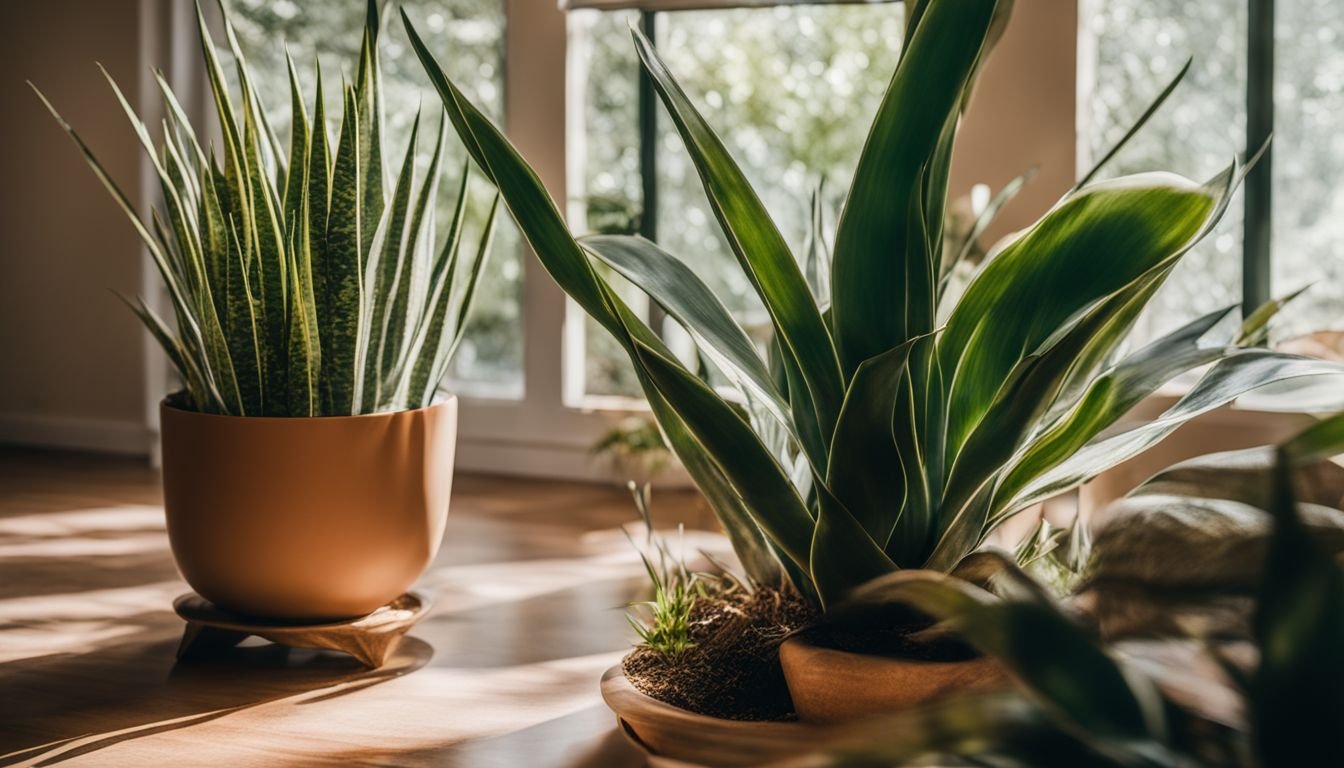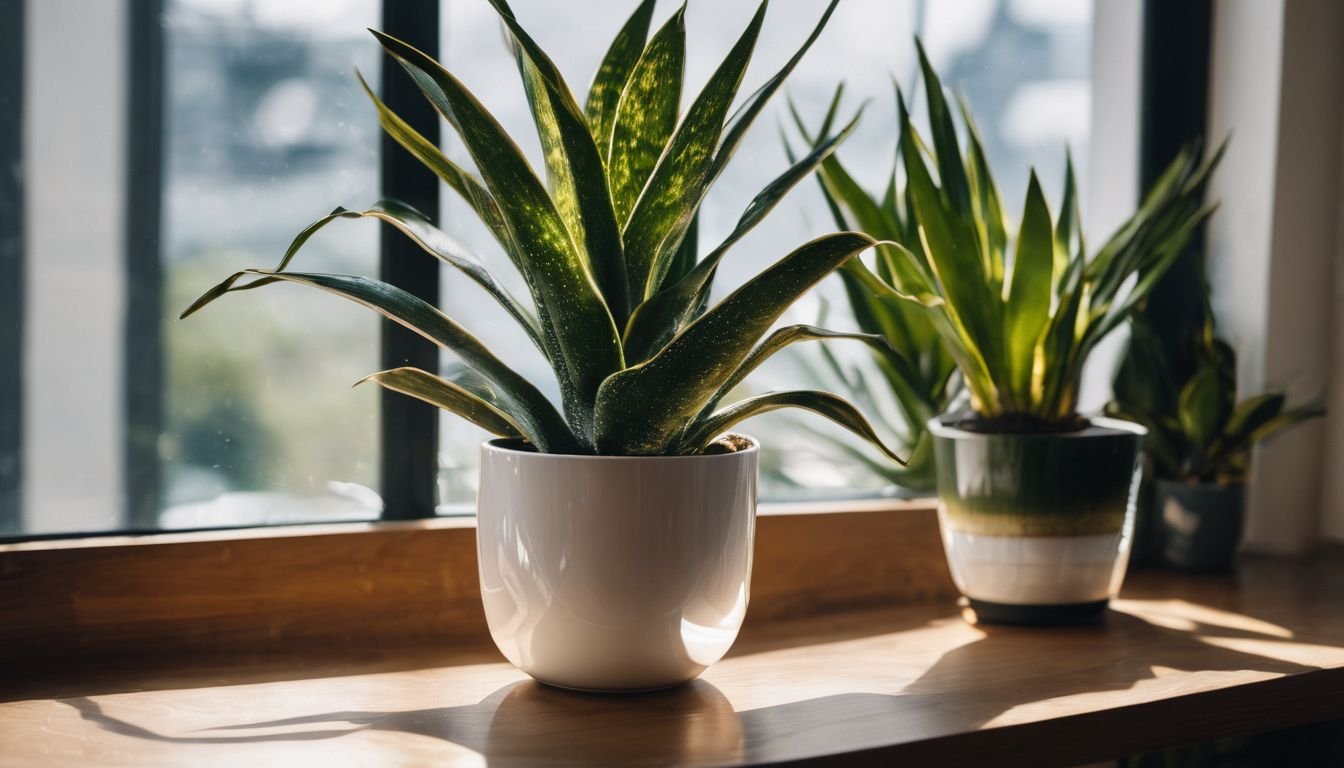G’day, plant lovers! Struggling to find that perfect indoor green mate that can cope with the ups and downs of Aussie life, especially when your thumb’s more grey than green? You’re definitely in good company.
Many of us yearn to spruce up our digs with a bit of foliage but end up feeling a bit downhearted after one too many plant casualties due to our full-on schedules.
But don’t chuck in the towel just yet! We’ve stumbled across an ace solution that’s tough as nails and easy on the eyes: Sansevieria trifasciata, better known as the snake plant or mother-in-law’s tongue.
Not only does this stunner gussy up the place, but it’s also a dab hand at purifying indoor air. It’s been making quite the splash at The Australian Plant Shop, available in sizes that’ll fit just about any nook or cranny you’ve got going spare.
After delving deep into research and giving it a burl ourselves, we’ve rounded up all the top tips for keeping this hardy gem thriving in your abode.
Our blog is chock-a-block full of advice on picking out the perfect spot for your new leafy mate, along with how to tackle any snags you might hit along the way—with simple fixes anyone can manage.
Keen to turn your home into an effortlessly lush sanctuary? Stick around!
Key Takeaways
- Sansevieria Trifasciata, also named snake plant or mother-in-law’s tongue, is a top-notch indoor plant for Aussie homes due to its striking look and air-purifying ability.
- This durable plant thrives in low light, making it perfect for areas of your home that don’t get much natural sunlight. It needs minimal watering, allowing the soil to dry out completely before giving it another drink.
- Keep your snake plant in indirect sunlight and avoid overwatering to prevent root rot. Repot only when necessary into well-draining soil meant for succulents or cacti.
- Regularly check for pests like spider mites and mealybugs. Use neem oil or insecticidal soap spray early on to handle these issues without stress.
- The Australian Plant Shop is a great resource for further guidance on caring for Sansevieria Trifasciata and other plants, ensuring successful indoor gardening efforts.
Description and Features of Sansevieria Trifasciata

Turning our focus to Sansevieria Trifasciata, often celebrated under the monikers “snake plant” or “mother-in-law’s tongue,” this indoor plant stands out for its unique appearance and minimal care requirements.
Its stiff, upright leaves boast a mesmerizing pattern that varies from green with yellow margins to fully variegated foliage, depending on the variety. Not just a pretty face, these leaves also play a crucial role in purifying indoor air quality by absorbing toxins through pores on their surface – an invaluable trait for fostering healthier living spaces.
We find Sansevieria Trifasciata incredibly forgiving when it comes to care. It thrives amidst neglect, embodying resilience with high drought tolerance and an ability to adapt to low light levels.
This slow-growing marvel doesn’t need frequent watering thanks to crassulacean acid metabolism (CAM), allowing it to efficiently use water and withstand dry conditions indoors. Beyond its practical benefits like enhancing air quality and easy maintenance, the snake plant adds a touch of elegance with its structured form and vibrant variegation – making it a beloved choice among Australian homes seeking both beauty and functionality in houseplants.
Ideal Conditions for Growing Sansevieria Trifasciata

Creating the perfect environment for Sansevieria Trifasciata to thrive doesn’t require a green thumb, just a bit of know-how. We’ll guide you through setting up your home in Australia to meet its simple needs, ensuring it grows healthy and strong.
Light requirements
Sansevieria trifasciata, also known as mother-in-law’s tongue or viper’s bowstring hemp, loves thriving in low light levels. This makes it an ideal indoor plant for Aussie homes that may not be flooded with natural sunlight.
We’ve come to understand that not every corner of our homes can offer the bright sunbeam many plants crave. Yet, this resilient species defies those norms and grows beautifully even in dimly lit spaces.
It’s a myth that all houseplants require direct sunlight to flourish. Sansevieria trifasciata ‘laurentii’ breaks this stereotype by not just surviving but prospering in areas where other plants might struggle.
Our experience tells us placing it near a north-facing window or in a room with shaded light does wonders for its growth without compromising on the aesthetic appeal of your space.
Ensuring your Sansevieria gets adequate light doesn’t mean exposing it to harsh conditions; indirect light or artificial lighting works just fine for this slow-growing gem. This flexibility allows you to decorate with dracaena trifasciata across various parts of your home, even those far from windowsills or glass doors.
It’s about finding that perfect spot where the plant receives enough light to photosynthesise effectively while keeping its unique architectural beauty intact.
Watering schedule
We understand the art of keeping our indoor plants, especially the resilient Sansevieria Trifasciata or as we fondly call it, mother-in-law’s tongue, thriving in Aussie homes. It’s all about mastering its watering schedule.
This plant demands less water than most, requiring us to allow the soil to completely dry out before giving it another drink. We make sure to check the soil’s moisture level by sticking our fingers a few centimeters deep.
If it’s dry, it’s time for a water feast; if not, we hold off.
Careful watering practices help us avoid overwatering – a common misstep that could lead to root rot and slow growth. Given its ability to withstand droughts for brief periods, this ogum proves forgiving for those occasional memory slips on watering days.
Keeping air pollutants at bay while being low-maintenance makes mother-in-law’s tongue an excellent choice for Australian garden lovers seeking beauty without the fuss.
Maintenance Tips for Sansevieria Trifasciata
Caring for Sansevieria Trifasciata in Aussie homes is quite straightforward, thanks to its resilience and low-maintenance nature. Let’s dive into some essential maintenance tips that will keep your snake plants healthy and thriving.
- Lighting Loves: Place your Sansevieria in indirect sunlight. Although it can adapt to low light conditions, bright, filtered light encourages stronger growth. Avoid direct sun, as it can scorch the leaves.
- Water Wisely: Watering your Sansevieria correctly is crucial. These plants prefer drying out between waterings. During the warmer months, water every 2-3 weeks and reduce frequency during winter to prevent root rot.
- Humidity & Temperature: Sansevieria Trifasciata enjoys typical indoor temperatures ranging from 18°C to 24°C but can tolerate higher levels without harm. Average home humidity levels are adequate; however, avoid placing it in overly draughty areas.
- Soil & Repotting: Use a well-draining potting mix designed for succulents or cacti to ensure proper drainage and prevent moisture buildup around the roots. Repotting is rarely needed – only consider this every 2-3 years or if the plant outgrows its current pot.
- Leaf Care: Keep the leaves clean by gently wiping them with a damp cloth to remove dust and ensure efficient photosynthesis through their stomata. This also helps in maximising its air-purifying qualities.
- Pest Patrol: Inspect regularly for pests such as spider mites and mealybugs, common issues that can be easily managed with neem oil or insecticidal soap spray when spotted early on.
- Trimming Tips: Trim any yellow or damaged leaves at the base with clean shears to keep your plant looking tidy and encourage new growth.
Common Issues and their Solutions
Having covered maintenance tips for Sansevieria Trifasciata, we now shift our focus to tackling some of the common issues you might encounter and how to solve them. These practical solutions will keep your snake plants thriving.
- Overwatering poses a significant threat, often leading to root rot. The best way to avoid this problem is by allowing the soil to completely dry out before adding more water. This approach ensures your plant gets just the right amount of moisture without the risk of excess water harming its roots.
- Poor drainage can also be detrimental, as it may cause water to pool around the roots, leading to similar issues as overwatering. To prevent this, opt for a well-draining soil mix specifically designed for succulents or cacti. This type of soil allows water to flow through easily, ensuring that roots stay healthy.
- Spider mites and mealybugs are pests that sometimes attack Sansevieria Trifasciata, impacting its health severely. Addressing these pests promptly with insecticidal soap or neem oil can make a big difference. Apply the treatment according to instructions and repeat if necessary until you’ve fully managed the infestation.
- Inadequate sunlight can cause your snake plant to become weak and develop a leggy appearance. Ensure it receives plenty of bright, indirect light throughout the day for optimal growth and vigour. If natural light is limited, consider supplementing with grow lights.
- Frequent fertilisation can do more harm than good, leading to fertiliser burn. Stick to fertilising your Sansevieria Trifasciata sparingly—only during the growing season—and follow the recommended dosage on your fertiliser’s label closely.
- Finally, when your snake plant shows signs of being root – bound in its current pot, don’t hesitate to repot it into a larger container. Providing enough space for roots to grow freely is crucial for maintaining a healthy plant and preventing issues related to overcrowding such as stunted growth.
Explore More Plant Guides
After tackling the common issues associated with Sansevieria Trifasciata, we reckon it’s time to broaden our horizons with more plant guides. The Australian Plant Shop offers a treasure trove of knowledge for enthusiasts keen on expanding their green thumb skills.
Diving into these guides reveals secrets on nurturing a variety of plants that can enhance your home’s atmosphere and possibly improve air quality, potentially reducing asthma triggers.
Our collection doesn’t just stop at care tips; it delves deep into the botanical characteristics and environmental impacts of each plant in Australia. This plethora of information is especially useful for those wanting to make informed decisions about their indoor gardens.
From peer-reviewed articles to firsthand gardening successes, we share insights that empower you to cultivate a thriving green space within your home.
Conclusion
Growing and maintaining Sansevieria Trifasciata in Aussie homes proves it’s a breeze for plant lovers of all levels. With its minimal care requirements, this tough succulent fits perfectly into busy lifestyles.
Remember to provide the right balance of light and water, and you’ll have a thriving snake plant adding style and greenery to your space. It’s our hope that with these guidelines, your home will soon boast healthy, beautiful Sansevieria plants.
Let’s make our homes greener together!
FAQs
1. What is the best spot to place my Sansevieria Trifasciata in my home?
Place your Sansevieria Trifasciata in a spot with indirect sunlight for optimal growth.
2. How often should I water my Sansevieria Trifasciata?
Water your Sansevieria Trifasciata every 2-6 weeks, depending on the season and humidity levels.
3. Does Sansevieria Trifasciata need special soil?
Use well-draining soil or a cactus potting mix for your Sansevieria Trifasciata to prevent root rot.
4. Can I keep my Sansevieria Trifasciata outside in Aussie climate?
Yes, you can keep it outside, but ensure it’s sheltered from direct sunlight and heavy rain.
5. How do I know if my Sansevieria Trifasciata needs repotting?
Repot your plant when roots begin crowding the container or growing through drainage holes.
